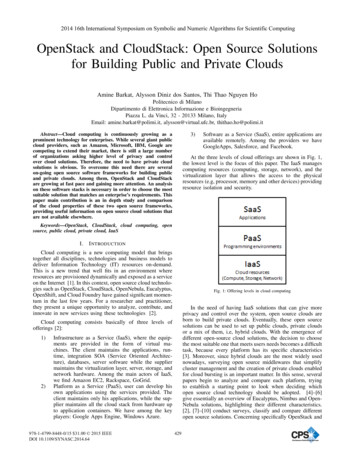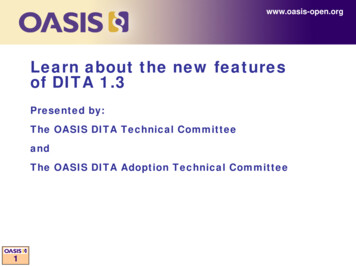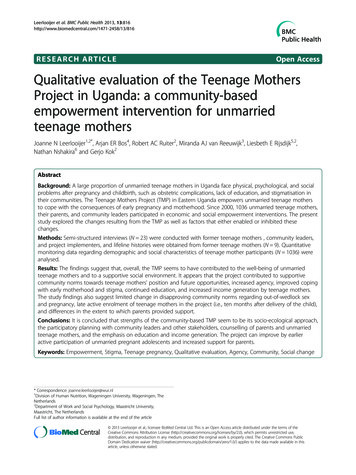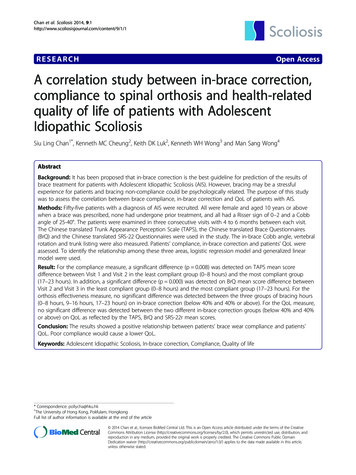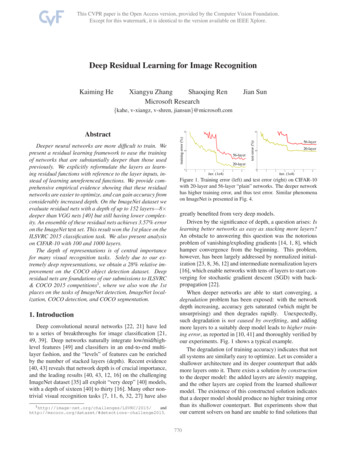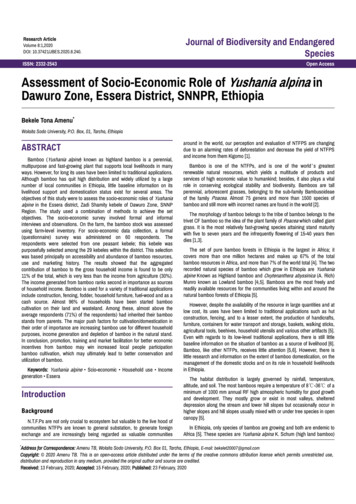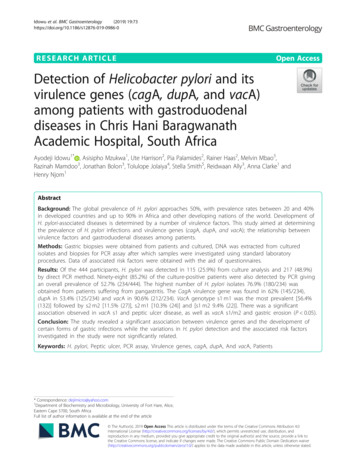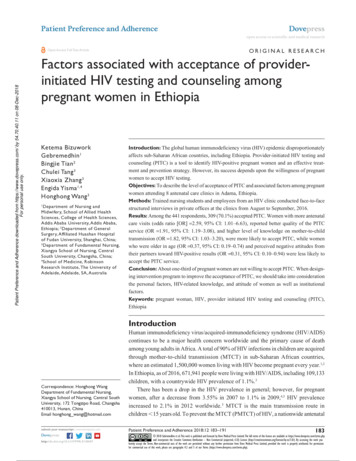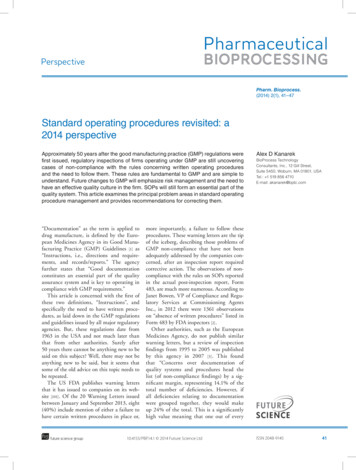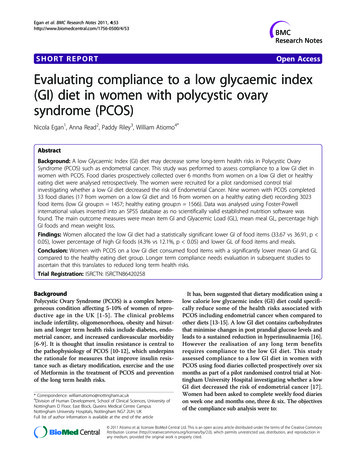
Transcription
Egan et al. BMC Research Notes 2011, RT REPORTOpen AccessEvaluating compliance to a low glycaemic index(GI) diet in women with polycystic ovarysyndrome (PCOS)Nicola Egan1, Anna Read2, Paddy Riley3, William Atiomo4*AbstractBackground: A low Glycaemic Index (GI) diet may decrease some long-term health risks in Polycystic OvarySyndrome (PCOS) such as endometrial cancer. This study was performed to assess compliance to a low GI diet inwomen with PCOS. Food diaries prospectively collected over 6 months from women on a low GI diet or healthyeating diet were analysed retrospectively. The women were recruited for a pilot randomised control trialinvestigating whether a low GI diet decreased the risk of Endometrial Cancer. Nine women with PCOS completed33 food diaries (17 from women on a low GI diet and 16 from women on a healthy eating diet) recording 3023food items (low GI group:n 1457; healthy eating group:n 1566). Data was analysed using Foster-Powellinternational values inserted into an SPSS database as no scientifically valid established nutrition software wasfound. The main outcome measures were mean item GI and Glyacemic Load (GL), mean meal GL, percentage highGI foods and mean weight loss.Findings: Women allocated the low GI diet had a statistically significant lower GI of food items (33.67 vs 36.91, p 0.05), lower percentage of high GI foods (4.3% vs 12.1%, p 0.05) and lower GL of food items and meals.Conclusion: Women with PCOS on a low GI diet consumed food items with a significantly lower mean GI and GLcompared to the healthy eating diet group. Longer term compliance needs evaluation in subsequent studies toascertain that this translates to reduced long term health risks.Trial Registration: ISRCTN: ISRCTN86420258BackgroundPolycystic Ovary Syndrome (PCOS) is a complex heterogeneous condition affecting 5-10% of women of reproductive age in the UK [1-5]. The clinical problemsinclude infertility, oligomenorrhoea, obesity and hirsutism and longer term health risks include diabetes, endometrial cancer, and increased cardiovascular morbidity[6-9]. It is thought that insulin resistance is central tothe pathophysiology of PCOS [10-12], which underpinsthe rationale for measures that improve insulin resistance such as dietary modification, exercise and the useof Metformin in the treatment of PCOS and preventionof the long term health risks.* Correspondence: william.atiomo@nottingham.ac.uk4Division of Human Development, School of Clinical Sciences, University ofNottingham D Floor, East Block, Queens Medical Centre CampusNottingham University Hospitals, Nottingham NG7 2UH, UKFull list of author information is available at the end of the articleIt has, been suggested that dietary modification using alow calorie low glycaemic index (GI) diet could specifically reduce some of the health risks associated withPCOS including endometrial cancer when compared toother diets [13-15]. A low GI diet contains carbohydratesthat minimise changes in post prandial glucose levels andleads to a sustained reduction in hyperinsulinaemia [16].However the realisation of any long term benefitsrequires compliance to the low GI diet. This studyassessed compliance to a low GI diet in women withPCOS using food diaries collected prospectively over sixmonths as part of a pilot randomised control trial at Nottingham University Hospital investigating whether a lowGI diet decreased the risk of endometrial cancer [17].Women had been asked to complete weekly food diarieson week one and months one, three & six. The objectivesof the compliance sub analysis were to: 2011 Atiomo et al; licensee BioMed Central Ltd. This is an open access article distributed under the terms of the Creative CommonsAttribution License (http://creativecommons.org/licenses/by/2.0), which permits unrestricted use, distribution, and reproduction inany medium, provided the original work is properly cited.
Egan et al. BMC Research Notes 2011, 4:53http://www.biomedcentral.com/1756-0500/4/531. Assess the current methods of measuring compliance to a low GI diet and determine the most effective way for use with food diaries.2. Measure compliance to a low GI diet for womenon a low GI 600 kcal deficit diet comparing the proportion of GI foods in the diet of this group tofoods eaten by women on a healthy eating 600 kcaldeficit diet.3. Determine whether there was any decrease incompliance over the course of the six month study.MethodsThis study was conducted according to the guidelineslaid down in the Declaration of Helsinki and all procedures involving human subjects/patients were approvedby the Derbyshire Research Ethics Committee. RECreference number: 06/Q2401/76. Written informed consent was obtained from all subjects.Details of the methods used in the randomised controlled trial have been previously published [17] butbriefly; women had been recruited from gynaecologicalclinics at the Queens Medical Centre in Nottingham, andalso a dietician running a regular PCOS weight management clinic. Volunteers were also requested from a PCOSwebsite (http://www.pcos.i8.com) and posters displayed inthe Queens Medical Centre. The trial entry criteria were:an objective diagnosis of Polycystic Ovary Syndrome usingthe Rotterdam criteria, oligo or amenorrhoea, age above35, and a body mass index (BMI) calculated as weight inkilograms/height in metres squared, above 30. Exclusioncriteria included previous or current history of any cancer,use of the combined pill, progesterones or clomiphene,women about to undergo intrauterine insemination andin-vitro fertilisation. Women from the clinics and volunteers from other sources were invited to make contact toarrange further assessment. One thousand four hundredand thirty three new and 2598 follow up patients wereseen in 153 gynaecology clinics over 12 months. Of these,441 (11%) potentially eligible women were identified.Nineteen patients were identified who met the trial criteriaof which 11 were recruited to the trial and were randomised by a web based programme; six to a 600 kcal deficitlow GI diet and five to 600 kcal deficit hypocaloric healthyeating approach. The numbers allocated to each arm andrandomisation groups were unknown to the food diaryanalyst until data had been entered therefore single blinding the study.The women completed food diaries at the start of thestudy and then at one, three and six month stages. Baseline dietetic advice and information was provided andongoing support offered before the completion of thesediaries. The senior dietician involved in the studyexplained the protocol and distributed personal recordbooklets providing information for patients depending onPage 2 of 7the diet plan to which they were randomised. The booklets contained information on the particular diet,together with an appointment progress record and testresults. Patients were told to follow the diet as closely aspossible every day for six months and keep the food diaries with as much detail as possible. The diaries emphasised the importance of portion sizes and eatingbreakfast, lunch and an evening meal every day. Snackingwas allowed within the diet from a daily allowance totalling 250 kcal from a selection provided. These additionalcalories were included in the diet regimen. At least threeand a half hours of exercise a week was recommended,but no upper limit was set.The primary outcome measure was the mean GI offood items consumed as recorded in the food diaries.Secondary outcome measures included the proportion offoods consumed with a low GI, the mean GlycaemicLoads (GL) of food items and meals consumed, andchanges in weight, and BMI.A valid method of assessing compliance to a low GI dietthough food diaries was sought using an internet searchengine (Google), a literature search (Medline 1996 -present, Embase, CINAHL, BNI, Athens and Cochrane) andpersonal enquires from international and local dieteticexperts (Personal communication; discussions took placewith: Nottingham university (Moira Taylor, KirstenWhitehead, Arlene Barton); University of Glasgow (NigelDenby); University of Surrey (Gary Frost), Diabetes consultant; Clorado (David Mendosa); University of Sidney(Jennie Brand Miller, Alan Barclay) and University of Toronto (Thomas Wolever)). Enquiries suggested that therewas no scientifically valid established nutrition softwareavailable to accurately analyse the GI and GL of dietaryintake. Therefore an SPSS database was created populatedby internationally accepted GI values from the FosterPowell [16] international table of GI and GL values whichcombined all relevant data published between 1981 and2001 and included GI values for over 750 types of foods,with nearly 1300 separate entries. For the various foodsconsumed in the diaries, the best matched GI value wasassigned by manually reviewing the table which has beenused in many published studies [13,15,18-21], and wasrecommended by the experts contacted. If there were GIvalues for multiple brands of the same food, the averagevalue was taken. In cases where foods did not correspondto food types in published values, the GI was left absent.However foods containing little or no carbohydrate (suchas meat, poultry, fish, salad vegetables or eggs) wereassumed to be zero.The mean and median GI of food items, proportion ofhigh GI foods used and GL of food items and meals werecompared between women randomised to a low GI dietcompared to the healthy eating diet. Means were compared using the independent Students t-test, medians
Egan et al. BMC Research Notes 2011, e 3 of 7using the Mann-Whitney test and proportions using Chisquared. The difference in proportion of low mediumand high GI foods between the two groups was assessedby Chi squared and the One way Analysis of Variance(ANOVA) test was used to discover whether there was asignificant trend of mean GI and GL over the six monthperiod, supplemented by a multiple range test (if theANOVA was significant) to identify particular differences. Finally the accuracy of a commercially availablesoftware package (NutriGenie [22]) was analysed by comparing results generated using it with results generatedusing the SPSS package and measuring agreement usingthe Kappa test. A p value of 0.05 was considered statistically significant.ResultsThere was no significant difference in the clinical or biochemical the features in the women with PCOS enteredinto the either arm of the trial [17]. Overall, 33 of a possible 44 food diaries (75%) were completed by nine of the11 women originally randomised. 17 diaries were fromwomen randomised to a low GI diet and 16 diaries fromwomen on a healthy eating diet. Three thousand andtwenty three food items were recorded in these diaries(n 1457; low GI group and n 1566 healthy eatinggroup). Table 1 shows a summary of the completeness ofdata collection. There was no significant differencebetween the two arms in the number of diaries completed or clinic attendance as shown in table 2.The mean GI value in the group allocated a low GIdiet was significantly lower than the healthy eatinggroup (33.67 vs 36.91, p 0.05), and the low GI groupalso had a significantly different distribution of GIfoods in their diet with a higher percentage of low GIand medium GI foods (81.8% vs 74.6%) and a lowerpercentage of high GI foods (4.3% vs 12.1%, p 0.05)(Table 3).Table 4 shows the data across the six month trial period. The Mean GIs of the diets had been calculated atseveral time points after the diaries had been completedfor a week following the baseline advice given by thedietician. It can be seen from table 4 that the mean GIcalculated from the food diaries of women randomisedto the low GI group was lower at all time points evaluated which was consistent with the fact that women randomised to a low GI diet consumed less GI food, thuscomplying with the original advice provided with thedietician provided at the start of the study. It howeversuggests that as time progressed, adherence to the lowGI diet decreased. However, the significant differencewas between 0 and three months only (ANOVA p 0.02, 0-3 months p 0.044) and there was no evidenceof an overarching consistent trend with time. Table 5shows the increasing GL of foods and meals consumedover the first three months of the trial although this didnot continue into month six. Again there was a significant difference between 0 and three months only(ANOVA p 0.019, 0-3 months p 0.027) and therewas no evidence of an overarching consistent trend withtime.A post hoc sample size calculation showed that for thedifference in meal GI of food items in both groupsfound in our study (3.24), with a mean standard deviation of 27.32, the sample size required for an Alpha of0.05 and a power of 80% was 1118 food items pergroup. In our study, 1457 food items were evaluated inthe low GI group and 1566 in the healthy eating group.Women in both groups lost weight and reduced theirwaist and hip circumference and BMI with a 5.37%reduction in mean weight over six months [17] andthere was no significant difference between groups.The accuracy of the NutriGenie software was analysedby comparing results generated with the results fromanalysis using the SPSS database. There were 293 foodTable 1 Summary from all subjects of the results of the completeness of data collection for dietetic interventionParticipantnumberNumber of monthly diet clinicsattendedNumber of food diariescompletedWas the participant considered to complete opped out854Yes900Dropped out1064Yes1100Dropped out
Egan et al. BMC Research Notes 2011, e 4 of 7Table 2 A comparison of completed food diaries and clinic attendance from all subjects for each study armWomen randomised to 600 kcal deficitLow GI diet (n 6)Women randomised to 600 kcal deficitHealthy Eating diet (n 5)Number of diet clinics attended (% of totalpossible attendances)*24 (66.7%)22 (73.3%)Number of food diaries completed (% of totalpossible diaries)*17 (70.8%)16 (80.0%)Number of food items recorded in the diariesWeek 1499371Number of food items recorded in the diariesMonth 1475412Number of food items recorded in the diariesMonth 3275387Number of food items recorded in the diariesMonth 6208396*Includes all people recruited to trial.items in the diaries, 190 (64.8%) of which had an allocated GI value. These were categorised into low mediumand high GI, using the internationally accepted criteria,to allow comparison with the NutriGenie databasewhich had originally been considered to analyse thedata. Only 107 items (36.7%) from the diaries wereavailable on the NutriGenie database and 91 (31.1%)food items had both NutriGenie and Foster-Powellbased SPSS database values. Table 6 compares theagreement between the NutriGenie and SPSS databasewhere it can be seen that nine items classified as low inthe SPSS database were classed as high in the NutriGenie. These and all other differences between the twodatabases were examined at source and the values onthe SPSS database were checked back to the international database to ensure that there was no transcribingerror. No transcribing errors were found although allitems classified as low in the database had values bordering the medium classification. The poor agreementbetween methods was confirmed by a Kappa test valueof 0.316 [23].DiscussionThis study showed that women with PCOS compliedwith a low GI diet. There was a significantly lower meanGI of food items and GL of food items and meals inwomen randomised to the low GI arms of the trial compared to the healthy eating arm. The results suggestedthat compliance decreased as the study progressedalthough the mean GI and GL of food items and GL ofmeals were lower at all stages in the low GI group compared to the healthy eating group. The average GI offood items was 8.8% lower in the low GI group. The proportion of low, medium and high GI foods also differedsignificantly between the two arms, and the intake ofhigh GI foods was lower in the low GI group. As far aswe know, this was the first study to have assessed compliance to a low GI diet by analysing the GI value of dataTable 3 Glycaemic Index of food recorded in food diaries from all subjects throughout the 6 month studyWomen Randomised to 600 kcal deficitlow GI diet No. (%)Total No. ItemsItems with GI value present (from internationaldatabase/assigned zero)Women Randomised to 600 kcal deficithealthy eating diet No. (%)145715661251 (85.9%)1358 (86.7%)Classification of foods*Low GI (55 or less)889 (61.0%)919 (58.7%)Medium GI (56-69)299 (20.5%)249 (15.9%)High GI (70 )No valueMean GI**Confidence IntervalStandard deviation of meanMedian*Significant difference using Chi squared (p 0.0005).**Significant difference using independent t-test (p 0.003).63 (4.3%)190 (12.1%)206 (14.1%)208 846
Egan et al. BMC Research Notes 2011, e 5 of 7Table 4 Summary of mean and median Glycaemic Index value of items and % high GI for the 6 month trial periodfrom all subjects1 week1 month3 months6 monthsTotalMean GI low GI diet30.7134.0036.4536.4933.67Mean GI healthy eating diet33.7537.0837.3039.5336.91Median GI low GI diet3738444838Median GI healthy eating diet3846444846% High GI on low GI diet1.8%5.1%6.9%5.3%4.3%% High GI on healthy eating diet12.1%10.4%13.4%12.6%13.4%prospectively collected in food diaries and there were nopublished studies to compare the findings with.The study was limited by various factors. A key limitation was the small sample size but although the study hada small number of women entered, the majority of diarieswere well completed and the data available were large, sooverall statistically significant differences were observable.However trends and sub group analysis were not statistically significant due to the small sample size. Althoughselection bias was limited due to randomisation, the smallsample size may have increased the potential effect fromvolunteer bias and non-participation bias. Of those volunteering or referred to the trial only 19 met all eligibility criteria, 11 entered the trial and nine completed the trial. It ismore likely that women who dropped out of the trialwould not have complied with the dietary intervention,increasing the chance of the results showing compliance.However, a strength of the study was that it was linked toa rigorously conducted CRUK pilot which had consistententry criteria, thorough randomisation, and good dieteticsupport for participants. The diaries were set out in a wayencouraging a high level of detail, potentially allowing allfood and drink consumed each day with quantities to berecorded. Printed recording booklets for food intakeprompted patients for the desired information and structured data in an organised way facilitating data analysis.This assessment method, when completed properly, was arobust way of gathering data and has been shown to havea beneficial reactivity effect [24] increasing compliance.Another limitation was the lack of universal agreement on the GI values of foods, whether drinks such astea and coffee should be included and the complexitiesaround how to account for issues such as ripeness offruit and specific combinations of foods which potentially affect each other. No account of food interactionswas included in the analysis. The inclusion of standardportion sizes could have introduced inaccuracy but thiswill not have affected the results related to GI of fooditems recorded.Although this study was single blinded, informationbias could have occurred. The dietician knew whichstudy arm patients were allocated to and more importantly the patients knew what intervention they werehaving in terms of low GI or healthy eating diet. Inaddition, the self monitoring by patients meant thatcontrol of data collection was the patient’s full responsibility so the accuracy of the data relied on the patient’scompliance to keeping the diary. The potential for biasin self completed diaries where the individuals knewwhat intervention they should be following was high.Less desirable eating episodes may have been excludedfrom the diaries, biasing the monitored behaviour in thedesired direction. There was also the possibility of recallbias where information may have been entered retrospectively from memory leading to inaccurate recordings. The Hawthorne effect could have introduced biasduring the whole study but particularly during the fourweeks out of the six month trial that patients wereTable 5 Summary of mean and median Glycaemic Load of food items and meals for the 6 month trial period from allsubjects1 week1 month3 months6 monthsTotalMean item GL low GI diet6.648.589.658.898.15Mean item GL healthy eating diet8.609.1510.1810.949.81Median item GL low GI diet1.864.384.484.453.54Median item GL healthy eating diet2.064.484.536.864.48Mean meal GL low GI diet21.3427.4324.7222.5624.16Mean meal GL healthy eating diet26.8629.9031.0033.7330.40Median meal GL low GI diet18.5522.5523.4518.8320.28Median meal GL healthy eating diet24.4025.3628.5325.3426.79
Egan et al. BMC Research Notes 2011, e 6 of 7Table 6 Comparison of NutriGenie and SPSS database for91 foodsNutriGenieSPSS 215High00101050103191required to fill in a food diary and the diaries may nothave been representative of the other 20 weeks thepatients were expected to comply with the dieteticadvice. The direction of these biases would be toincrease the likelihood of finding compliance to a lowGI diet but the five percent weight loss in both arms ofthe trial suggests that the calorie deficit and/or exercisecomponent was complied with. However it is not possible to totally rule out the Hawthorne effect in behaviourally based studies or to truly blind the participants todietetic interventions.The internationally accepted range for low GI intake is0-55 and both groups in the study had an average GI offood items and GL of foods that was low. The average GIfor items was 33.67 for the low GI arm and 36.91 for thehealthy eating group. The average GL of items for thelow GI diet was 8.15 and 9.81 for those on the healthyeating diet and it is suggested that the GL of items is lowwhen under or equal to the value of 10 [25]. These effectsmay be the result of the general advice and informationgiven by the dieticians as many of the healthy eating dietfoods suggested, such as salads, fruit and vegetables weresimilar to those suggested for the low GI diet and usuallyhave a low GI. The main high GI foods within the diarieswere potato and certain breads and breakfast cereals ofwhich the participants of the low GI diet were advised toavoid in the personal record booklet suggesting all participants followed dietetic advice.After enquires to find an appropriate programme toassess the food diaries it became apparent that an affordable commercial database was not available. The NutriGenie software initially looked a possible solution forqualitative analysis of whether the diet was predominantlylow GI. However there was poor agreement of food classification when comparing NutriGenie and the SPSS database which used nationally published and accepted values(Kappa 0.316). NutriGenie, despite claiming thousandsof entries, contained significantly fewer foods from the diaries. It is not surprising that the commercial programmecontained less relevant foods than the SPSS database asthe latter was purpose made, but the difference in allocation of a food group to low, medium and high was surprising. The company marketing the NutriGenie softwarewas reticent in giving information about sources ofinformation for their database, but this is an illustration ofthe complexity of analysing the GI of diets accurately andalso gives an understanding of the view of some healthprofessionals that it is too complex to be a basis for dietaryintervention.This study, although small, is of interest due to thepotential benefits of a low GI diet for the treatment ofPCOS associated diabetes and obesity and the increasingly strong suggestion that the endocrine and metabolicabnormalities present in PCOS produce an associationwith endometrial cancer [1,2,5,9].A low GI diet where reduction of insulin levels lowerstestosterone levels, improves hirsutism and acne,improves menstrual function, dislipidaemia and potentially decreases the risk of endometrial cancer[1,11,13-15] has led to support for its use in both obeseand lean patients with PCOS [26]. Realisation of anylong term benefits such as cancer prevention wouldrequire compliance to the low GI diet. This study suggests that compliance is possible over a six month period, although longer term compliance would still needto be assessed. The benefits of lifestyle intervention indiabetics [27] show that a slightly restricted but healthylifestyle can reduce long term health problems linkedwith insulin resistance and this study suggests that itmight be possible for women with PCOS.ConclusionsWomen with PCOS allocated to a low GI diet consumed food items with a significantly lower mean GIand GL compared to the healthy eating diet group.However, challenges in accurately assessing complianceto a GI diet were identified, particularly the impracticality of the dietician and participants being blind to thearm of the trial. This and various other confoundingvariables were likely to have worked in the direction ofincreasing the likelihood of finding compliance to thedietetic advice although unlikely to remove the differences found between the two groups. This study gives adegree of confidence, but no absolute confidence, that ifa full study to determine the effects of low GI diet onwomen with PCOS takes place it is likely the intervention will be complied with. Such a trial will give theopportunity for longer term compliance to be assessed.The benefits of lifestyle intervention in people with diabetes show that it is possible for dietary modificationand exercise aimed at achieving a weight loss of 5-10%to reduce the risk of long term health problems linkedwith insulin resistance and it is important to confirmthis finding in women with PCOS.AcknowledgementsWe would like to thank Mary Golding, Paul Silcocks, Nuguelis Razali,Sabitabrata Sarkar, Paul Hardiman, Jim Thornton and Louise Hart who
Egan et al. BMC Research Notes 2011, ped with the primary randomised controlled trial. We would also like tothank the women who participated in the study. This work was presentationat the FIGO world congress of Obstetrics and Gynaecology in Cape TownSouth Africa, October 2009 and was funded by a grant from CancerResearch UK, Lincoln’s Inn Fields, London, UK, WC2A 3PX (Reference C20654/A7380) and departmental funds from the Division of Human Development,School of Clinical Sciences, University of Nottingham.Author detailsNottingham Medical school, University of Nottingham D Floor, East Block,Queens Medical Centre Campus Nottingham University Hospitals,Nottingham NG7 2UH, UK. 2Department of Dietetics and Nutrition, QueensMedical Centre Campus, Nottingham University Hospitals, Nottingham NG72UH, UK. 3School of Clinical Sciences, University of Nottingham D Floor, EastBlock, Queens Medical Centre Campus Nottingham University Hospitals,Nottingham NG7 2UH, UK. 4Division of Human Development, School ofClinical Sciences, University of Nottingham D Floor, East Block, QueensMedical Centre Campus Nottingham University Hospitals, Nottingham NG72UH, UK.1Authors’ contributionsNE summarised and analysed the data in the food diaries, wrote up andedited the drafts of the paper for publication. AR provided the dieteticadvice to the participants, supervised the collection of data contained in thefood diaries and edited the drafts of the paper for publication. PR providedstatistical support and edited the drafts of the paper for publication. WAconceived of the idea, organised and ran the primary randomised controlledtrial, supervised the collection of data, data analysis and edited the drafts ofthe paper for publication. All authors read and approved the finalmanuscript.Competing interestsThe authors declare that they have no competing interests.Received: 23 December 2010 Accepted: 8 March 2011Published: 8 March 2011References1. Knochenhauer ES, Key TJ, Kahsar-Miller M, Waggoner W, Boots LR, Azziz R:Prevalence of the polycystic ovary syndrome in unselected black andwhite women of the southeastern United States: a prospective study.J Clin Endocrinol Metab 1998, 83:3078-3082.2. Diamanti-Kandarakis E, Kouli CR, Bergiele AT, Filandra FA, Tsianateli TC,Spina GG, Zapanti ED, Bartzis MI: A survey of the polycystic ovarysyndrome in the Greek island of Lesbos: hormonal and metabolicprofile. J Clin Endocrinol Metab 1999, 84(11):4006-11.3. Moran C, Tena G, Moran S, Ruiz P, Reyna R, Duque X: Prevalence ofpolycystic ovary syndrome and related disorders in Mexican women.Gynecol Obstet Invest 2010, 69(4):274-80.4. Sheehan MT: Polycystic Ovarian Syndrome: Diagnosis and Management.Clinical Medicine & Research 2004, 2(1):13-27.5. Hardiman P, Pillay OS, Atiomo W: Polycystic ovary syndrome andendometrial carcinoma. Lancet 2003, 361:1810-1812.6. Balen AH, Conway GS, Kaltsas G, et al: Polycystic ovary syndrome: thespectrum disorder in 1741 patients. Human Reproduction 1995, 10(8):p2107-2111.7. Franks S: Diagnosis of Polycystic Ovarian Syndrome: In defence of theRotterdam Criteria. J Clin Endocrinol Metab 2006, 91(3):786-789.8. Fauser BCJM, et al: Revised 2003 consensus on diagnostic criteria andlong-term health risks related to polycystic ovary syndrome (PCOS).Human Reproduction 2004, 19(1):41-47.9. Wild RA: Long term health consequences of PCOS. Human ReproductionUpdate 2002, 8(3):231-241.10.
This study was performed to assess compliance to a low GI diet in women with PCOS. Food diaries prospectively collected over 6 months from women on a low GI diet or healthy eating diet were analysed retrospectively. The women were recruited for a pilot randomised control trial investigating whether

